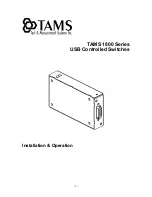
4-3
Catalyst 2360 Switch Hardware Installation Guide
OL-22150-02
Chapter 4 Troubleshooting
Diagnosing Problems
10/100/1000 Port Connections
A port appears to malfunction:
•
Use the Mode button to show the status for all ports.
and
describe the LEDs and
their meanings.
•
Use the
show interfaces
privileged EXEC command to see if the port is error-disabled, disabled, or
shutdown. Re-enable the port if necessary.
SFP and SFP+ Module
Use only Cisco SFP or SFP+ modules in the switch. Each Cisco module has an internal serial EEPROM
that is encoded with security information. This encoding provides a way for Cisco to identify and
validate that the module meets the requirements for the switch.
•
Inspect the SFP module. Exchange the suspect module with a known good module. Verify that the
module is supported on this platform. (The switch release notes on Cisco.com list the SFP modules
that the switch supports.)
•
Use the
show interfaces
privileged EXEC command to see if the port or module is error-disabled,
disabled, or shutdown. Re-enable the port if needed.
•
Make sure that all fiber-optic connections are properly cleaned and securely connected.
Interface Settings
Verify that the interface is not disabled or powered off. If an interface is manually shut down on either
side of the link, it does not come up until you re-enable the interface. Use the
show interfaces
privileged
EXEC command to see if the interface is error-disabled, disabled, or shutdown on either side of the
connection. If needed, re-enable the interface.
Ping End Device
Ping from the directly connected switch first, and then work your way back port by port, interface by
interface, trunk by trunk, until you find the source of the connectivity issue. Make sure that each switch
can identify the end device MAC address in its Content-Addressable Memory (CAM) table.
Spanning Tree Loops
STP loops can cause serious performance issues that look like port or interface problems.
A unidirectional link can cause loops. It occurs when the traffic sent by the switch is received by its
neighbor, but the traffic from the neighbor is not received by the switch. A broken fiber-optic cable, other
cabling problems, or a port issue could cause this one-way communication.
You can enable UniDirectional Link Detection (UDLD) on the switch to help identify unidirectional link
problems. For information about enabling UDLD on the switch, see the “Understanding UDLD” section
in the switch software configuration guide on Cisco.com.
















































